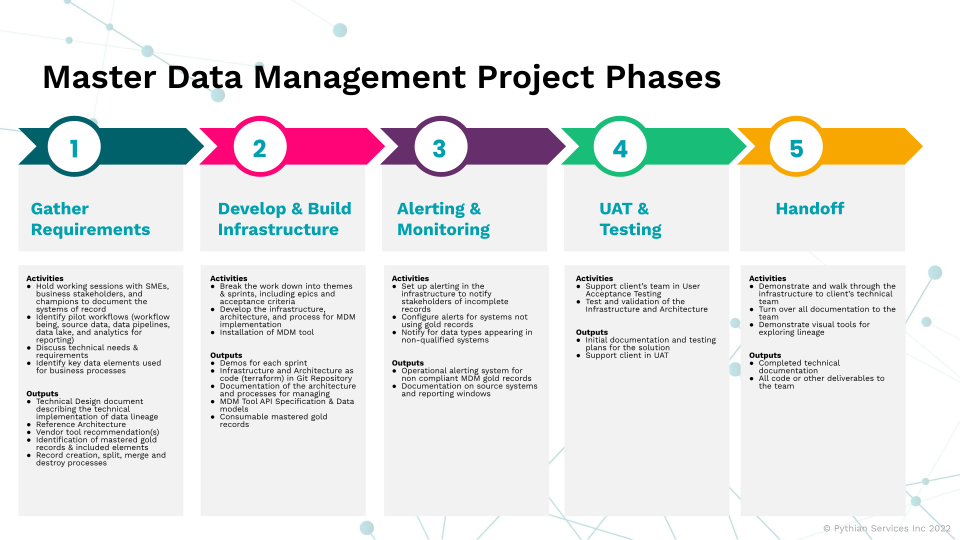Approaching Master Data Management

Our previous post focused on ‘lightweight governance’ – enabling engineering and product teams across an organization to execute with a high level of autonomy. This drives success by having access to context regarding policies and standards, shared technology tools for consumption and data literacy programs that are constantly elevating the capability of the entire organization.
Technology enablement and core services focus on provisioning of core services, automation and tools used by teams to be compliant with organizational policies and standards. Data governance teams have accountability for systems design, deployment and enablement to ensure teams can successfully adopt the identified tooling. One of the most common technologies deployed and managed by data governance teams is master data management (MDM), a shared service to ensure that one copy of a record and associated data elements is consistently used across the organization and a central reference point uniformly updated by multiple systems, business processes and users.
MDM is not only the central service for storing and managing gold records. It is the supporting business processes and operational models to ensure all systems have access to high quality and consistent data. Operational models ensure decisions about record lifecycle are being made by those closest to the business impact and consumers of the data. Many organizations will have specific teams tasked with the operational ownership of gold records stored within and MDM service and with specific tools and technology built to assist them in managing the lifecycle of mastered records.
MDM is not for all data. It’s for those types of records that are critical to customer experience, business process controls and financial controls. The types of records we master should focus on those that enable later linking and reporting of data and must always be up to date to ensure that key business decisions are well informed and consistently executed. The most commonly mastered data elements include:
-
Customers – The most commonly mastered data record is the customer. This gold record usually consists of key details about a customer and their relationship to a company including social media details, physical address, location preferences, compliance obligations, application preferences and links to past purchase or engagement history. Commonly called Customer360, this record is used to ensure the customer only updates personal details once and all organizational systems and processes reference the same data for driving customer interactions and experiences.
-
Products – Many organizations will create gold records for their products that contain standard product naming, regional availability information and details about pricing and cost basis. These datasets can be expanded to include details about quality standard, manufacturing processes or third party supplier details.
-
Suppliers – Building on product information, suppliers are commonly mastered to ensure systems that need to process orders, manage financials and predict outcomes are working from the same details about supplier’s capabilities, contracts, pricing structures and geographic presence.
-
Locations – Organizations that have many locations, including restaurant chains or grocery stores, will often master gold records about each location including address, lease specifics, facility details, access details and local third party maintenance contractors of record. This data ensures consistency in reporting across systems for stock-evolution and logistics, facility maintenance and cost structures.
-
Financial Structure – Financial hierarchies are common data relationships to master. Creating a single record of departments and cost centers enables all systems to uniformly report on financial allocations and P&L performance. These records will commonly contain details about the name of the department, primary contacts and approvers for financial decisions and details about the ability to capitalize costs allocated to the business unit.
Implementing MDM capabilities can often be overwhelming for an organization starting from a level of limited or no existing functionality. The simultaneous building of new technology while standing up new operational teams for data management can prove to be complex and will most likely require constant iteration to improve on technology and organizational design. We manage to five consistent phases when implementing MDM, while visually shown linearly, the process is an agile one with constant checks on progress toward the defined outcomes, constant measures of the quality of our MDM hosted data and improvements to our business processes to streamline execution.
Master Data Management is often the first centralized service deployment by data governance teams, enabling organizations to reference common sets of gold records including customer, supplier, products, locations and financial hierarchies. This single source of truth enables downstream processes to be of higher trustworthiness and provide a richer and more uniform customer experience. All MDM programs should set out and focus on building technology and supporting operational tech structures in parallel so that processes and technology are designed together, creating scalable processes for managing data as complexity and volume grows.
Share this
Next story
Defining your Data Strategy →
You May Also Like
These Related Stories
Data Monetizations Impact on Data Governance


Data Monetizations Impact on Data Governance
Oct 14, 2022
4
min read
Data Governance in Legacy Environments


Data Governance in Legacy Environments
Oct 3, 2022
3
min read
Understanding the Scale of our Data Governance Program
![]()
Understanding the Scale of our Data Governance Program
Oct 19, 2022
3
min read
No Comments Yet
Let us know what you think